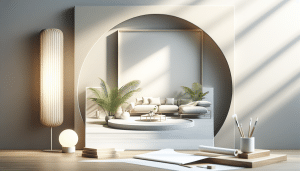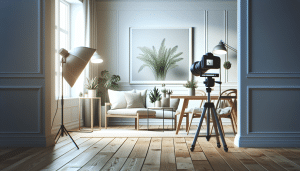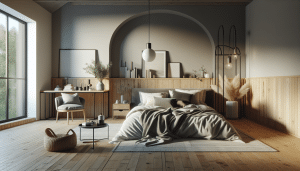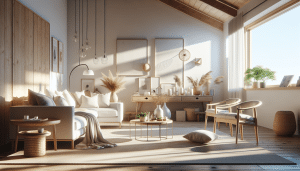Small Changes That Make Your Home Feel Luxurious
Samantha Lee September 23, 2025
Unlock the secrets to transforming your everyday living space with effortless touches. This guide reveals how subtle updates, smart décor decisions, and mindful organization can elevate your home’s style on any budget while highlighting popular trends in interior design.
Embracing Minimalism for Modern Living
The concept of minimalism continues to inspire many homeowners who wish to create a space that feels calm, uncluttered, and sophisticated. Minimalist interiors emphasize clear surfaces, streamlined furniture, and a harmonious choice of color palettes. By reducing visible clutter and favoring quality over quantity, rooms often appear larger, brighter, and more inviting. This approach is not limited to stark white rooms; subtle, warm tones and natural textures are just as prevalent in making a home feel serene yet expressive. The popularity of minimalism in modern interior design can be attributed to the increasing need for peaceful retreats from busy lives (Source: https://www.nytimes.com/guides/realestate/home-decor-ideas).
Minimalism isn’t only about removing excess. It’s about intentionality—choosing each item for a reason and allowing spaces to breathe. Many discover that investing in a few timeless pieces, like a sculptural light fixture or a sleek sofa, makes a noticeable difference in how a room feels. Hidden storage, floating shelves, and multi-purpose furniture help keep surfaces uncluttered while maintaining a sense of warmth and comfort. This subtle luxury is often more achievable than people realize, making it accessible to those wanting a high-end look on an average budget.
Creating a minimalist space can also support wellbeing. Clean, uncluttered environments minimize distractions and help reduce everyday stress. Those adopting minimalist decor often report feeling lighter and more organized. Even adopting minimalist habits in just one room—like the bedroom—can yield noticeable improvements in personal relaxation and sleep quality. As minimalism continues to influence trending home aesthetics, it proves that tranquility and luxury are within easy reach for many households.
Layering Textures and Fabrics for Depth
Layered textures and lush fabrics play a pivotal role in transforming a living space from ordinary to extraordinary. Mixing soft throws, plush rugs, and velvet cushions immediately brings a tactile richness, making a room feel thoughtfully composed. Contrasting materials—like pairing smooth leather with chunky knits or glossy ceramics with rough-hewn wood—add visual intrigue often found in upscale interiors. This design tactic is not just about aesthetics; it’s about crafting a welcoming space that invites touch and comfort (Source: https://www.architecturelab.net/upscale-your-home-interior/).
One way to experiment with layering involves stacking area rugs or draping throws over sofas and beds. Textile layering works wonders in both cold and warm climates; lighter, breathable fabrics for summer and thick, insulating layers for colder months keep a home feeling cozy year-round. Experimenting with materials like silk, faux fur, linen, and jute allows homeowners to reflect personality and style without major renovations. Swapping out textiles is an affordable way to refresh the look of a room seasonally.
Texture has the power to elevate even the simplest room design. Adding tactile contrast through wall panels, cushions, or curtains breaks up monotony and makes the space more engaging. Subtle details such as decorative stitching, tufting, or fringe can make off-the-shelf items feel bespoke. Through layering, anyone can create spaces that feel dynamic, inviting, and effortlessly luxurious, regardless of the home’s original layout or size.
Lighting Upgrades That Make a Difference
Lighting ranks among the most transformative elements for a stylish home interior. Thoughtfully chosen ambient, task, and accent lighting instantly changes the mood and functionality of any room. Layering light sources—such as table lamps, sconces, dimmable ceiling lights, or even carefully placed LED strip lighting—provides flexibility for every need and time of day. Lighting upgrades are often among the first changes interior experts recommend when seeking to elevate an environment’s ambiance (Source: https://www.houzz.com/magazine/lighting-as-a-luxury-upgrade-in-interior-design-stsetivw-vs~141013375).
The introduction of smart lighting systems, which can be programmed via smartphone or voice assistant, adds both convenience and luxury. These systems allow control over color, brightness, and even scheduling, tailoring the experience to personal preference. Strategic use of warm-toned bulbs helps create a relaxing, welcoming atmosphere perfect for living rooms and bedrooms. In kitchens and workspaces, cooler, brighter lights enhance focus and visibility, bridging both form and function.
Statement lighting fixtures, like sculptural pendants or elegant chandeliers, draw the eye upward and can serve as art pieces in their own right. Incorporating reflective surfaces, such as mirrors or metallic finishes, helps distribute light throughout the room, making smaller spaces appear larger and more airy. By focusing on different layers of lighting, anyone can create a high-impact, sophisticated look without extensive remodeling work.
Smart Organization for Effortless Tidiness
Clutter can undermine even the most beautiful interior design. Smart organization strategies help maintain a feeling of luxury throughout your home. Built-in cabinetry, under-bed drawers, and closet systems maximize storage without sacrificing aesthetics. Incorporating organizational solutions that blend with your décor, such as open shelving or elegant baskets, keeps essentials accessible yet hidden from view. This approach to tidy living is a cornerstone among home organization experts (Source: https://www.goodhousekeeping.com/home/organizing/g1397/home-organization-ideas/).
Simplified storage not only boosts comfort but also enhances mental clarity. When every item has a designated place, daily routines—like meal prep or getting ready for the day—become smoother. Innovative products, such as modular organizers or multi-functional furniture, reflect a growing focus on blending beauty with practicality. Open-concept living spaces especially benefit from concealed storage, preventing visual overload and making large rooms feel calm and ordered.
Organization doesn’t need to be rigid or sterile. Decorative baskets, racks, and fabric bins can add texture while concealing everyday items. Seasonal decluttering, where unnecessary or out-of-use objects are donated or recycled, preserves the calm atmosphere synonymous with luxury spaces. Over time, these considerate habits create homes that function beautifully—and are always ready for welcoming guests.
Incorporating Statement Pieces for Personality
Personalizing your home with statement pieces—like unique artwork, bold area rugs, or vintage finds—can instantly elevate the overall perception of luxury. These elements inject character and become conversation starters, distinguishing the home from standard catalogue designs. Selecting one or two stand-out items per room allows for self-expression without creating visual clutter. The appeal of curated design is on the rise, championed by both DIY enthusiasts and professional decorators (Source: https://www.elledecor.com/design-decorate/trends/g27208583/home-decorating-ideas/).
Large-scale artwork or eye-catching furniture can anchor a space, providing a focal point around which other design elements revolve. There’s no need to splurge; even thrifted or handcrafted items can achieve a dramatic effect. The art of mixing styles—such as combining mid-century modern with industrial touches—often exemplifies confidence and creativity, traits that signal the homeowner’s unique taste.
Gallery walls, sculptural vases, and collectable objects are all valid choices when looking to add personality. When thoughtfully placed, these pieces support the overall style narrative without overpowering the room. Experimenting with color, scale, or material lets homeowners find what resonates, ultimately creating interiors that feel personal, luxurious, and vibrant all at once.
Bringing Nature Inside With Biophilic Design
Biophilic design—integrating natural elements into indoor environments—remains a highly sought-after trend in luxury and wellness-centric homes. Bringing the outdoors inside can be as simple as placing potted plants, arranging fresh cut flowers, or opting for botanical-inspired artwork. The connection to nature not only enhances visual beauty but also supports psychological wellbeing, helping to reduce stress and improve air quality. Evidence continues to build for the beneficial impacts of indoor greenery (Source: https://www.healthline.com/health/mental-health/benefits-of-plants-in-your-home).
For those with limited space or light, alternatives like preserved moss walls, terrariums, or faux plants offer a similar aesthetic boost with less maintenance. Wood, stone, and water features, even in subtle accents like coasters or planters, contribute to a more grounded, organic feel. Open windows for fresh air, or use natural materials in finishes and accessories throughout the home to enhance the effect of biophilic design.
Plants can be chosen for both beauty and function—many varieties help purify air or provide culinary herbs for the kitchen. Strategic positioning of greenery near windows, shelves, or countertops creates pockets of tranquility throughout the home. As biophilic design grows in popularity, many discover that connecting with nature indoors is an affordable way to boost luxury and promote wellness.
References
1. The New York Times. (n.d.). Home Decor Ideas. Retrieved from https://www.nytimes.com/guides/realestate/home-decor-ideas
2. Architecture Lab. (n.d.). Upscale Your Home Interior. Retrieved from https://www.architecturelab.net/upscale-your-home-interior/
3. Houzz. (n.d.). Lighting as a Luxury Upgrade in Interior Design. Retrieved from https://www.houzz.com/magazine/lighting-as-a-luxury-upgrade-in-interior-design-stsetivw-vs~141013375
4. Good Housekeeping. (n.d.). Home Organization Ideas. Retrieved from https://www.goodhousekeeping.com/home/organizing/g1397/home-organization-ideas/
5. Elle Decor. (n.d.). Home Decorating Ideas. Retrieved from https://www.elledecor.com/design-decorate/trends/g27208583/home-decorating-ideas/
6. Healthline. (n.d.). Benefits of Plants in Your Home. Retrieved from https://www.healthline.com/health/mental-health/benefits-of-plants-in-your-home







